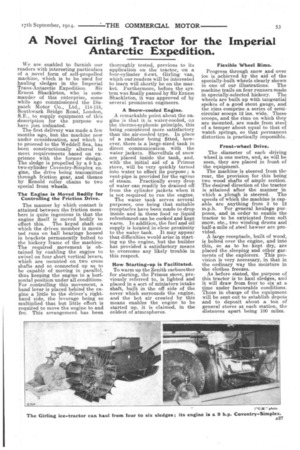A Novel Girling Tractor for the Imperial Antarctic Expedition.
Page 19

If you've noticed an error in this article please click here to report it so we can fix it.
We are enabled to furnish our readers with interesting particulars of a novel form of self-propelled machine, which is to be used for hauling sledges in the Imperial Trans-Antarctic Expedition. Sir Ernest Shackleton, who is commander of this enterprise, some while ago commissioned the Dispatch Motor Co., Ltd., 114418, Southwark Bridge Road, London, S.F., to supply equipment of this description for the purpose we have just indicated.
The first delivery was made a few months ago, but the machine now under consideration, and which is to proceed to the Weddell Sea, has been constructionally altered to meet requirements based on exprience with the former design. The sledge is propelled by a 9 h.p. two-cylinder Coventry-Simplex engine, the drive being transmitted through friction gear, and thence by Renold roller chains to two special front wheels.
The Engine is Moved Bodily for Controlling the Friction Drive.
The manner by which contact is attained between the friction members is quite ingenious in that the engine itself is moved bodily to effect this. The keyed shaft on which the driven member is mounted runs on ball bearings housed in brackets permanently bolted to the hickory frame of the machine. The required movement is obtained by enabling the engine to swivel on four short vertical levers, which are mounted on two cross shafts and so connected up a,s to be capable of moving in parallel, thus keeping the engine in a horizontal position under all conditions. For controlling this movement, a hand lever is placed behind the engine a little -to the driver's righthand side, the leverage being so multiplied that but little effort is required to move the engine to and fro. This arrangement has been
thoroughly tested, previous to its application on the tractor, on a four-cylinder 6-cwt. Girling van, which our readers will be interested to learn will shortly be on the market. Furthermore, before the system. was finally passed by Sir Ernest Shackleton, it was approved of by several prominent engineers.
A Snow-cooled Engine.
A remarkable point about the engine is that it is water-cooled, ea the thermo-syphonie principle, this being considered more satisfactory than the air-cooled type. In place of a radiator being fitted, however, there is a large-sized tank in direct communication with the water jackets. Shovelfuls of snow are placed inside the tank, and, with the initial aid of a Primus stove, will be very quickly turned into water to effect its purpose ; a vent-pipe is provided for the egress of steam. Practically every drop of water can readily be drained off from the cylinder jackets when it is not required to run the engine.
The water tank serves several purposes, one being that suitable receptacles have been made to drop inside and in these food or liquid refreshment can be cooked and kept warm. In addition, the fuel and oil supply is iodated in close proximity to the water tank. It may appear that difficulties would arise in starting up the engine, but the builder has provided a satisfactory means to overcome any likely trouble in this respect.
How Starting-up is Facilitated. To warm up the Zenith carburetter for starting, the Primus stove, previously referred to, is lighted and placed in a sort of miniature intake shaft, built in the off side of the cover which surrounds the engine, and the hot air created by this means enables the engine to be started up, it is claimed, in the coldest of atmospheres. Flexible Wheel Rims.
Progress through snow and over ice is achieved by the aid of the specially-built wheels clearly shown in one of our illustrations. The machine trails on four runners made in specially-selected hickory. The wheels are built up with tangential spokes of a good. stout gauge, and the rims comprise a series of semicircular scoops 12 ins. wide. These scoops, and the rims on which they are mounted, are made from steel of a temper about equal to that of
watch springs, co that permanent distortion is practically impossible. Front-wheel Drive.
The diameter of each driving wheel is one metre and, as will be seen, they are placed in front of the equipment.
The machine is steered from the rear, the provision for this being two wood shafts of ample section. The desired direction of the tractor is attained after the manner in which a plough is steered. The speeds of which the machine is capable are anything from 3 to 12 m.p.h. For general haulage purposes, and in order to enable the tractor to be extricated from soft snow, etc., two winding drums and half-a-mile of steel hawser are provided.
A large receptacle, built of wood, is bolted over the engine, and into this, so as to be kept dry, are placed the sleeping and other garments of the explorers. This provision is very necessary, in that in the ordinary way the moisture in the clothes freezes.
As le,efore stated, the purpose of this tractor is to haul sledges, and it will draw from four to six at a time under favourable conditions. Those in charge of the equipment will be sent out to establish depots and to deposit about a, ton of general stores at each station, the distances apart being 100 miles.






















